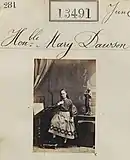
Mary Fox-Strangways, Countess of Ilchester (born Mary Eleanor Anne Dawson; 1852–1935) was an Anglo-Irish noblewoman, an anti-suffragist and a leading figure in London society.[1] She was the wife of Henry Fox-Strangways, 5th Earl of Ilchester.
Life


Mary Eleanor Anne Dawson was born in 1852, the fourth child and only daughter of Richard Dawson, 1st Earl of Dartrey and Augusta Stanley.[2] She married Henry Fox-Strangways, 5th Earl of Ilchester on 8 February 1872 and became the Countess of Ilchester. The couple had two children: Giles Fox-Strangways, 6th Earl of Ilchester and Muriel Augusta (Fox-Strangways) Digby.[3] The family lived at Holland House after the Countess' husband took over the property in 1899.[4] The Ilchesters also owned the Abbotsbury Gardens. The Countess published a catalogue of the garden's 4000 plants in 1899.[5] In 1902, she edited and published a collection of the letters of Lady Sarah Lennox.[6]
The Countess was active in the anti-suffrage cause. She founded the London branch of the Women's National Anti-Suffrage League in South Kensington in 1908.[7] Together with the Duchess of Montrose and others, she published an article in the Pall Mall Magazine titled "Why Women Should Not Have the Vote, From the Woman’s Point of View."[8] A member of the Primrose League, she advocated for Conservative politics.[9][10] She also served as president of the Women's Unionist and Tariff Reform Association.[11]
References
- ↑ Schutte, K. (2014). Women, Rank, and Marriage in the British Aristocracy, 1485-2000: An Open Elite?. Springer. ISBN 9781137327802. Retrieved 6 September 2019.
- ↑ Lodge, Edmund (1877). The Peerage and Baronetage of the British Empire as at Present Existing. Hurst and Blackett, Publishers. pp. 168, 331. Retrieved 18 June 2019.
- ↑ "Person Page: Lady Mary Eleanor Anne Dawson". The Peerage. Retrieved 6 September 2019.
- ↑ "HOLLAND PARK, Kensington and Chelsea - 1000811". Historic England. Retrieved 6 September 2019.
- ↑ "ABBOTSBURY GARDENS, Abbotsbury - 1000707 | Historic England". Historic England. Retrieved 6 September 2019.
- ↑ Napier, Lady Sarah Lennox Bunbury; Holland, Henry Fox; Ilchester, Mary Eleanor Anne Dawson; Ilchester, Giles Stephen Holland Fox-Strangways; Napier, Henry Edward (1902). "The life and letters of Lady Sarah Lennox, 1745-1826, daughter of Charles, 2nd duke of Richmond, and successively the wife of Sir Thomas Charles Bunbury, and of the Hon: George Napier; also a short political sketch of the years 1760 to 1763, by Henry Fox, 1st lord Holland;". London, J. Murray. Retrieved 6 September 2019.
- ↑ Harrison, Brian (2012). Separate Spheres: The Opposition to Women's Suffrage in Britain. Routledge. ISBN 9780415623360. Retrieved 6 September 2019.
- ↑ "The Pall Mall magazine (1913)". Hathi Trust. London: George Routledge & Sons. Retrieved 6 September 2019.
- ↑ Gottlieb, Julie V.; Toye, Richard (2013). The Aftermath of Suffrage: Women, Gender, and Politics in Britain, 1918-1945. Springer. ISBN 9781137333001. Retrieved 6 September 2019.
- ↑ Auchterlonie, Mitzi (2007). Conservative Suffragists: The Women's Vote and the Tory Party. I.B.Tauris. ISBN 9780857711595. Retrieved 6 September 2019.
- ↑ Thackeray, David (2010). "Home and Politics: Women and Conservative Activism in Early Twentieth-Century Britain". Journal of British Studies. 49 (4): 826–848. doi:10.1086/654913. ISSN 0021-9371. JSTOR 23265725. PMID 20941876. S2CID 27993371.
External links
- 1873 portrait of Mary Ilchester - Royal Household Portraits
- Watercolor painted by Mary, Countess of Ilchester - In the Royal Collection Trust